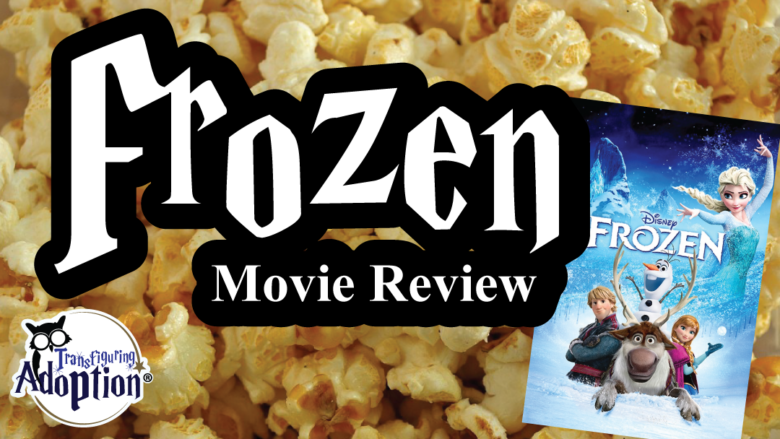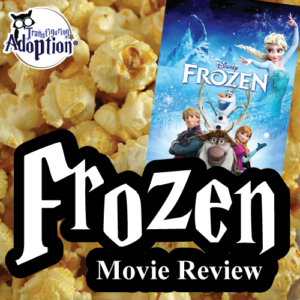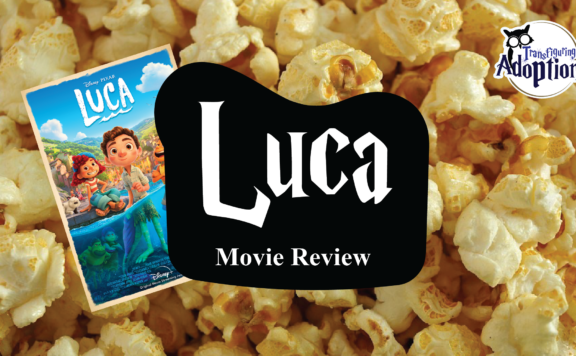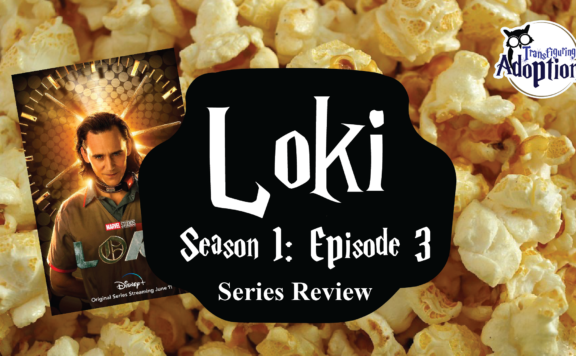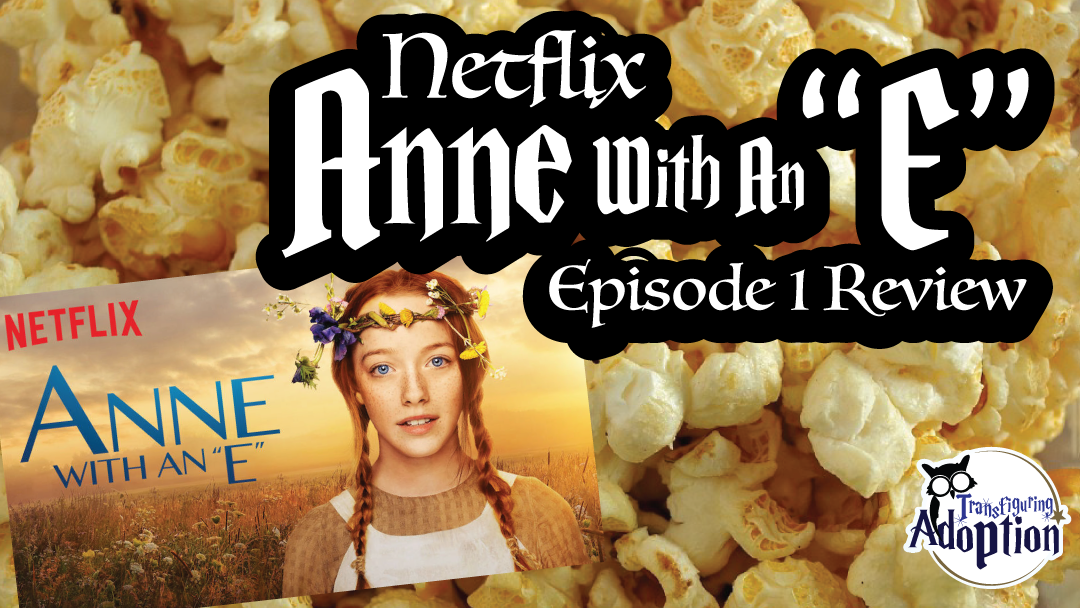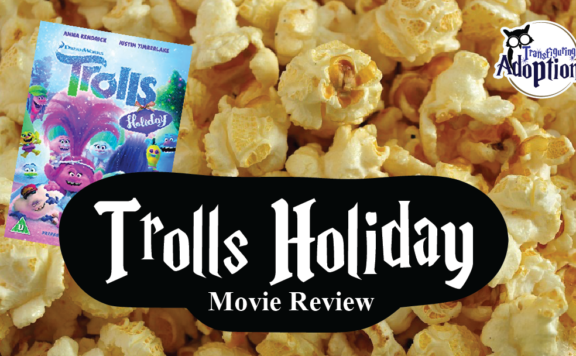Grade:
Transfiguring Adoption awarded this movie 4 Hoots out of 5 based on how useful it will be for a foster/adoptive family. [Learn more about our Hoot grading system here]
Movie Info:
- Rating: PG
- Genre: Action & Adventure, Animation, Comedy, Kids & Family
- Runtime: 102 minutes
- Studio: Walt Disney Pictures
From the Cover of Frozen (2013) by Walt Disney Pictures:
“Featuring the voices of Kristen Bell and Idina Menzel, “Frozen” is the coolest comedy-adventure ever to hit the big screen. When a prophecy traps a kingdom in eternal winter, Anna, a fearless optimist, teams up with extreme mountain man Kristoff and his sidekick reindeer Sven on an epic journey to find Anna’s sister Elsa, the Snow Queen, and put an end to her icy spell. Encountering mystical trolls, a funny snowman named Olaf, Everest-like extremes and magic at every turn, Anna and Kristoff battle the elements in a race to save the kingdom from destruction.”
Transfiguring Adoption’s Overview:
The target audience appears to be children ages 5 and up to view with a loving caregiver. It also appears this movie would be a great experience for any family, foster or adoptive, to enjoy together for a night of bonding. Elsa and Anna learning how to build relationships with one another after loss and discovering found family can be beneficial to any child learning how to make appropriate and safe connections with others.
** Spoilers Could Be Ahead **
How Is This Relevant To Adoption & Foster Care?
Early in the film Elsa and Anna experience a schism in their relationship with one another when Elsa’s powers cause Anna to become injured. To save her, all memories of Elsa’s powers had to be stopped and it was revealed that Elsa’s ice powers could bring disaster upon the family and the kingdom if left uncontrolled. As a result the children remained separate so Elsa could harness her powers. While searching for answers about Elsa’s powers their parents were killed in a storm at sea. Elsa responded to the tragedy by further withdrawing from her sister while her sister tried over the years to rekindle the close relationship they once shared to no avail.
As the ladies grow up and Elsa is crowned Queen they are introduced to many people in the surrounding kingdom. As seen before Queen Elsa keeps others at distance while Princess Anna clings hard and fast to positive attention from a young royal from a neighboring kingdom. As a result of the sisters’ strained relationships and Princess Anna’s poor emotional boundaries from trauma the ladies must each learn to grow from their traumatic pasts and save their beloved kingdom.
Like Queen Elsa and Princess Anna, children who have been in the child welfare system have endured trauma and as a result may not respond to conflict or other people in ways that compare to their peers. Though both girls suffered the loss of their parents they each responded to this trauma differently in an attempt to protect themselves. However, these coping mechanisms of withdrawing or attaching too quickly to an emotional connection do not help them once they venture outside of the safety of their locked castle. Children from the child welfare system often find what kept them safe before constantly brings trouble now and may not have the emotional intelligence to connect their feelings (and needs for safety and security) to their behaviors and very much need loving caregivers and friends that will love and support them while they learn these connections later in life.
Discussion Points:
- Not Hiding Your True Self
Many caregivers who work with children from the child welfare system are well acquainted with the term “Honeymoon Period” with new placements. This refers to the time when a family and child are carefully minding their Ps and Qs while learning how to live together. Children will be on their best behavior in hopes of this helping them return home or to prevent moving to yet another placement. However, when a child shifts from being told they are safe from actually feeling safe, at that point children will become more comfortable with letting down their walls and showing their true self. Queen Elsa desperately needed an environment with felt safety to help her make sense of storm swirling deep inside and that would have included a trauma-informed caregiver. Her emotions certainly fuel the intensity of her powers if left unchecked. While when behaviors come out caregivers may not feel this way, but this is when you are truly starting to earn a child’s trust and are exactly where you need to be! Like Queen Elsa, children who have experienced hard things need to be taught how to connect their feelings to their behaviors and that these behaviors do not define them. They need to know they are loved for who they are and not in spite of what they do when they “let it go.” It’s important for caregivers to also remember that mistakes don’t define us or our children as they can be incredible growth opportunities, as seen for both Queen Elsa and Princess Anna by the end of the film.
- Not All “True Love” Is Romantic
One thing I really loved in this movie as the parent of a young girl is the focus on other kinds of “love.” Don’t get me wrong, we all love a good romantic story sometimes but past Disney installations have elevated a romantic relationship far above any other loving relationship. Through the course of the film we see Princess Anna learn better emotional boundaries through a rushed, unhealthy relationship with Hans and a healthy, balanced relationship built over time and shared experiences with Kristoff. But most importantly, children are able to see how the bond between family can heal old wounds or even new ones through Princess Anna’s sacrifice for Queen Elsa and only Queen Elsa having the “true love” required to break the curse. Children who have endured trauma may long so much for closeness and love they may seek it from unloving people. As a result, children who have not had success with attachment to a primary caregiver may struggle like Princess Anna by falling too hard to fast or like Queen Elsa in keeping everyone, good or bad, at a distance. Children need a loving caregiver to teach appropriate boundaries and how to differentiate between “safe” and “unsafe” relationships with both peers and adults. - Earning Trust
Anyone else want to scream “YES!!” when Queen Elsa told Princess Anna she couldn’t marry a man she just met? I know I did! Probably a little awkward since I saw this movie on a Valentine’s date with my future spouse, but this was a message that for me set Frozen (2013) apart from so many of Disney’s princess movies. At that point in the film Hans had done nothing to earn any level of trust from Princess Anna and they had just met. It’s easy for us to laugh as adults, but realistically children from the child welfare system want that instant connection that Princess Anna thought she had with Hans. They desperately want the love and attention they are missing from household dysfunction and constant moves preventing laying down roots. As a result children from the child welfare system often need extra guidance in learning which relationships are safe enough to trust unconditionally. The good news is this can be healed and grown in the safety of a relationship with a caregiver committed to hanging in there and walking through these lessons with the child.
Cautionary Points:
- Death of Parents
Princess Elsa and Princess Anna lose their parents due to a tragic shipwreck in a storm. Some children may react to this tremendous loss as they may connect this to a death of a loved one in their life or to being separated from family of origin due to the child welfare system. - Princess Elsa Isolated from Others
While well intended to protect Princess Anna, Princess Elsa is isolated in the castle from everyone familiar while her parents work to help her control her powers. They also have her hide her powers in fear someone may try to harm Princess Elsa due to her powers. Though this was framed as a way to protect the girls this may be seen by a child as traumatic due to separations from their own siblings or feeling as though they were hidden from others due to issues in the family of origin. - Hans and Weselton are Abusive, Manipulative Creeps
I get it, we have to have some antagonists but these guys are royal creeps (pun intended). Hans is very manipulative and is attempting to use Princess Anna to gain notoriety as a royal and cares very little about her in the process. He frequently lies to other characters to encourage uprisings against the protagonists. Weselton’s self-interests also are harmful to Queen Elsa and Princess Anna and his disrespectful attitude and conniving ways to gain access to Arendelle add to the creep-o-meter. While not every child may be as creeped out as I was by these guys, some children may be all too familiar with the manipulative and abusive tactics used by these guys for self-gain and may be triggered by memories of abuse or neglect connected to selfish adults that should have protected them. - Characters Put in Prison
At different points several characters are arrested or imprisoned. While some of these are “bad guys” like Hans this also includes Princess Anna and Queen Elsa. Some children from the child welfare system may have poor connotations to law enforcement and imprisonment and may be triggered by any of the characters being handcuffed or locked up, especially if they have had family members with a history of arrests. - Fantasy Violence
There are sequences of violence with use of Queen Elsa’s ice magic, swords, and animals such as wolves. These sequences are not graphic and do not feature any blood or gore so this is not a high level of concern. However, some children who have endured trauma may be triggered by the suspense of these sequences or characters being injured due to over-stimulated stress response systems. - Elemental-Specific Accidents or Tragedy
Queen Elsa and Princess Anna’s parents are killed as sea when their ship wrecks during a large storm, Princess Anna nearly dies from being frozen, and the protagonists also have a few wrecks in the sleigh related to snow or chases from animals. Though these may not trigger most children, if a child has a trauma history that includes elemental features like water, ice, or snow this may be a piece to watch out for your children.
Discussion Guide:
- What is your favorite character? Who are you most like? Why?
Caregiver Note: This is an introductory question to get conversation started while working on an activity. Children may be thrown off if an adult asks suddenly about something serious right off the bat, so it’s good to start with a surface-level question to get the conversation going and get them thinking about the film. Also share your favorite character and who you related to the most and go first if your child is struggling. - Why did Princess Elsa stay by herself so much when she was younger?
Caregiver Note: Children often need help connecting feelings to behavior and this is a great way to help a child see his in action. Children may mention that she misses her parents, that she’s afraid of hurting Princess Anna, or that she’s afraid of getting hurt because she is different. Help your child connect that the grief and fear cause Princess Elsa to isolate and feel even more lonely. - Was there a time where you felt like Princess Elsa and you needed to stay away from others to stay safe?
Caregiver Note: Now that we’ve connected Princess Elsa’s feelings of fear and grief to her behavior we can help our child connect similar feelings. Isolating from others does not have to look like Princess Elsa locking herself in her room though. Does your child get angry and seem to push you away? This can be another way a child can create physical and emotional distance to keep themselves safe when they feel threatened. - What most makes you feel that way? How can I help you when it’s hard to talk about these feelings?
Caregiver Note: This is a great question that will help you and your child come up with a plan to communicate better when your child is overwhelmed. When overwhelmed language perception and expression can be difficult for a child who had endured trauma and may have deficits in this area due to abuse and neglect affecting their childhood development, no matter the age. This conversation will help you and your child to come up with a plan as a team so that maybe a code word can be shared or a gesture to indicate your child needs you to replace tantrums or other behaviors. Remember, though behaviors may be maladaptive their feelings are very real and valid and learning to express these emotions appropriately will help your child catch up in development as they learn to name and tame these big emotions. - ACTIVITY: Do You Want to Build a Snowman?
Caregiver Note: This is a great activity to do with your children while talking about the movie! You will need some ingredients to make “snow” (3 cups of baking soda and ½ cup of white hair conditioner mixed in a bowl), scissors, and some felt pieces for your snowman’s features and clothing. While discussing the movie help your child to make their own snowman. For extra fun, feel free to dress him or her up for summer since this snowman won’t melt like Olaf! - Why didn’t Princess Anna heal from “true love” with Hans or Kristoff?
Caregiver Note: This is a question that can start the discussion about how valuable familial and platonic love can be for your child. Movies and books often highlight romantic love as the end-all of needs for love and acceptance, and peers will also buzz about such things. However, this is a chance for you as the caregiver to talk to your child about having safe, balanced relationships in other areas of life and how important family, found family, and trustworthy friends can be as they grow older. - Who was able to heal Princess Anna with “true love”? How did Queen Elsa do that?
Caregiver Note: It’s important for us to remember that though Princess Anna can’t remember parts of the past, Queen Elsa remembers everything. And though Queen Elsa seems distant and reserved, we learn throughout the course of the film that her isolation was especially triggered by a need to protect her sister and that she fiercely loves Princess Anna. The sisters also show out on the ice that they are willing to sacrifice for one another. This is a very important discussion to have to help children understand why loving, appropriate relationships with friends and family are just as important, if not more, as romantic relationships. - Why did Princess Anna trust Hans so quickly? What are some ways she could have learned more about him sooner?
Caregiver Note: This is a great time to talk about emotional boundaries. Princess Anna wanted too much to feel loved and wanted that, after years of being alone in the castle, she immediately fell in love with the first pretty face that was nice to her. Your child may point out how nice and responsible he seemed when helping Arendelle or how good looking he is and charming. However, as we know there was a lot more than what Princess Anna saw on the surface. Talking about going on dates as a group to see how Hans talked to others, getting to know each other over time, and being open about boundaries may be some talking points to consider with ways she could have learned more sooner but your child may bring other insights to the conversation as well. - How did Kristoff show Princess Anna that he was worthy of her trust?
Caregiver Note: Kristoff is a wonderful example of how someone should earn trust. He is honest with Princess Anna and tells her the truth even when it’s hard, helps her with no expectations for returned favors, protects her from harm, maintains appropriate physical boundaries, and gets to know her family and friends. Over time Kristoff and Princess Anna are able to learn about one another safely and develop a (later successful) relationship over time. - ACTIVITY: Consent Carrots
Caregiver Note: Sven sure loves carrots! However, he probably needs to find some of his own instead of swiping Olaf’s nose so much without permission. It sounds like Sven needs a little lesson in asking for consent. This can be a great, and simple, activity to help children learn how to maintain good boundaries. First you will need your carrots. If raw carrots are not your thing, try making carrot chips with your child with the recipe below for a healthy snack alternative. After you have your snack ready talk to your child about consent. Explain to them that they have the ability to keep safe boundaries and to reinforce them by saying “no” and that they should respect others’ boundaries by asking before taking. Then, as you eat your consent carrots have everyone practice asking for consent for carrots they wish to take from others and saying yes or no. This is such an important lesson for all children, but especially children who have had their boundaries so frequently violated in abuse and neglect.
Carrot Chips Recipe:
– Carrots thinly sliced to ¼ inch thick. Can also be bought pre-sliced
– Olive Oil or Avocado oil
– Salt and Pepper
– Garlic Powder
